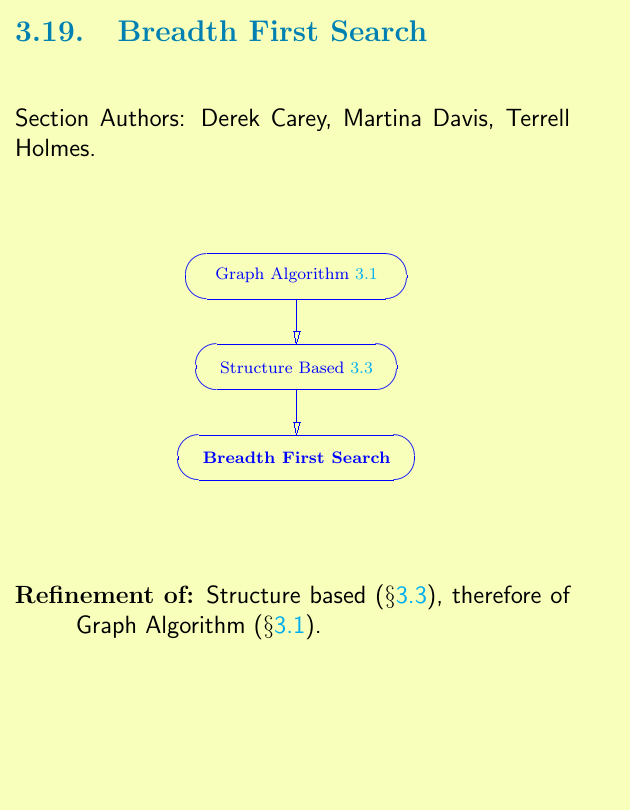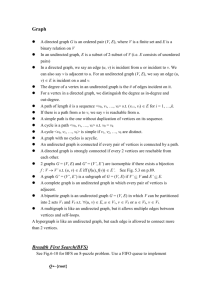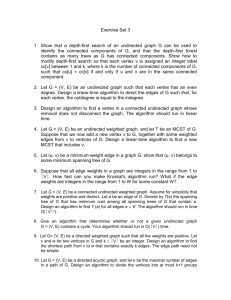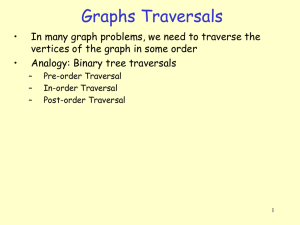3.19. Breadth First Search
advertisement

3.19. Breadth First Search Section Authors: Derek Carey, Martina Davis, Terrell Holmes. Graph Algorithm 3.1 Structure Based 3.3 Breadth First Search Refinement of: Structure based (§3.3), therefore of Graph Algorithm (§3.1). Prototype: template <class VertexListGraph, class P, class T, class R> void breadth_first_search(VertexListGraph& G, typename graph_traits<VertexListGraph> ::vertex_descriptor s, const bgl_named_params<P, T, R>& params);. Inputs: Inputs are a graph(directed or undirected) G = (V, E) and a source vertex s, where s is an element of V. The adjacency list representation of a graph is used in this analysis. Outputs: The outputs are a predecessor graph, which represents the paths traveled in the BFS traversal, and a collection of distances, which represent the distance of each of the vertices from the source vertex. Effects: The color property of each vertex in the graph will be set to black to symbolize that the vertex and all of its adjacent vertices have been visited. A distance from the source vertex and a predecessor vertex are assigned to each vertex in the graph. Asymptotic complexity: Let V = |V (G)| Let E = |E(G)|. Average case (random graph): O(V + E) Worst case (complete graph): O(V ∗ V ) Random Number Generator Specifications: Random Number Generator 1 C standard library rand() function Random Number Generator 2 Random Number Generator functor from the Boost library Testing Strategy Testing was performed on the Sun Microsystems Ultra 10 workstations. Random graphs were generated using the two random number generators specified above. Time tests were run on directed and undirected graphs of |V | = 100, 500, and 1000, with edge sizes ranging from |E| = |V | to |E| = |V 2 |. Each test was performed three times and the average of the BFS running time tests are displayed in the following tables. Table 1: Performance of BFS using Random Number Generator 1 on large directed and undirected graphs. (Time is represented in seconds) Random Number Generator 1 Vertices Edges Directed Undirected |V | |E| Graphs Graphs 100 100 0.00033 0.00177 100 1000 0.00746 0.01467 100 10000 0.06516 0.13467 500 500 0.00165 0.00855 500 5000 0.03640 0.07155 500 50000 0.33218 0.67370 500 250000 1.60266 3.35799 1000 1000 0.00296 0.01699 1000 10000 0.07283 0.14277 1000 100000 0.64975 1.35201 1000 1000000 6.50440 13.2974 Table 2: Performance of BFS using Random Number Generator 2 on large directed and undirected graphs. (Time is represented in seconds) Random Number Generator 2 Vertices Edges Directed Undirected |V | |E| Graphs Graphs 100 100 0.00056 0.00170 100 1000 0.00743 0.01426 100 10000 0.06856 0.13490 500 500 0.00166 0.00832 500 5000 0.03671 0.07134 500 50000 0.32464 0.67446 500 250000 1.61271 3.36002 1000 1000 0.00303 0.01693 1000 10000 0.07272 0.14272 1000 100000 0.67229 1.36000 1000 1000000 6.42800 13.4317 Figure 1: This chart is an average of the two tables based upon |V | = 100 Figure 2: This chart is an average of the two tables with |V | = 500 Figure 3: This chart is an average of the two tables with |V | = 1000 Pseudocode: BFS(G, s) for each vertex u in V[G] color[u] := WHITE d[u] := infinity p[u] := u end for color[s] := GRAY d[s] := 0 ENQUEUE(Q, s) while (Q != EMPTY) u := DEQUEUE(Q) for each vertex v in Adj[u] if (color[v] = WHITE) color[v] := GRAY d[v] := d[u] + 1 p[v] := u ENQUEUE(Q, v) endif endfor color[u] := BLACK end while return (d, p) Algorithm animation 1: Contains animations for a few AI and Search Algorithms Algorithm animation 2: Animation of BFS being performed on an undirected graph of 7 vertices. This graph shows the state of the queue, the distances being assigned to the vertices and the state of the predecessor graph. Algorithm animation 3: Animation of BFS being performed on a directed graph of 7 vertices. This graph shows the state of the queue, the distances being assigned to the vertices and the state of the predecessor graph. Acknowledgements This document and the reported performance measurements are an extension of those previously presented by Bob Bachman, Kadriye Vargun, Jeff Richards (Adopt − an − Algorithm2002)










